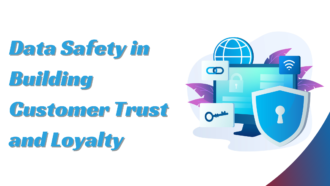Mastering Digital Transformation: Strategies for Effective Leadership
- 1 Strategies for Great Leadership For Digital Transformation
- 1.1 1. Understand the Need for Digital Transformation
- 1.2 2. Develop a Clear Vision and Strategy
- 1.3 3. Foster a Culture of Innovation
- 1.4 4. Lead by Example
- 1.5 5. Prioritize Digital Talent and Skills Development
- 1.6 6. Leverage Data and Analytics
- 1.7 7. Embrace Agile Methodologies
- 1.8 8. Collaborate Across Departments
- 1.9 9. Continuously Monitor and Adapt
- 2 Conclusion:
Digital transformation has become imperative for organizations to thrive in the modern marketplace. However, navigating this journey requires strong leadership, while only 44% of leaders feel prepared to handle the disruptions that digital transformation is likely to cause. In this article, we’ll discover the path of leading successful digital transformation step by step to ensure your business is ahead of competitors and well-prepared for innovative growth.
Strategies for Great Leadership For Digital Transformation
1. Understand the Need for Digital Transformation
Understanding the goals and needs for digitalization helps you create a clear focus to drive further action. Start by defining the driving forces behind digital transformation, such as evolving customer expectations, technological advancements, and market disruptions. Analyze what drivers work for you and follow the lead.
As Netflix did, at one point, they recognized the streaming tendency and embraced it to disrupt the traditional video rental industry. At the same time, their direct competitor, Blockbuster, failed to adapt and lost the audience.
2. Develop a Clear Vision and Strategy
Now that you know what you can get from digital transformation, define how it aligns with your company goals and values and formulate that into a distinct vision. Develop a comprehensive strategy outlining the steps needed to achieve the vision, including technology adoption, process optimization, and cultural change. Defined statements will help you ensure alignment across the organization and provide a roadmap for driving digital initiatives forward with clarity and focus.
Here’s another famous example: Starbucks decided to enhance customer experience through digital technology. They’ve developed a mobile app that allows customers to order ahead, earn rewards, and personalize their drinks, driving customer engagement and loyalty without compromising that sense of connection their audience gets each time buying a coffee.
3. Foster a Culture of Innovation
Cultivate an environment where experimentation and risk-taking are encouraged. As you’re the driver of digital transformation in your company, you empower employees to embrace new technologies and ideas, fostering a culture of continuous learning and improvement.
Your employees are an excellent source of brilliant ideas for your growth, not just blind executives. For example, products like Gmail and Google Maps have emerged from such an initiative, demonstrating the power of fostering innovation within the workplace.
4. Lead by Example
Demonstrate commitment to digital transformation by actively participating in initiatives and championing change, driving cultural change and innovation from the top down. Lead with transparency and open communication, keeping stakeholders informed throughout the transformation journey.
Let your example inspire and motivate employees to embrace digital transformation initiatives, fostering a sense of ownership, commitment, and accountability throughout the organization.
5. Prioritize Digital Talent and Skills Development
Enhance organizational capabilities and competitiveness by equipping employees with the knowledge and expertise to leverage digital technologies effectively. A good idea is to invest in training and upskilling programs to ensure employees have digital skills to drive transformation.
Recruit top talent with expertise in emerging technologies and digital strategies to supplement existing capabilities or outsource software development to a professional vendor and get the necessary tools. Either way, ensure your team has all the means required to achieve the global business goals.
6. Leverage Data and Analytics
Analyzing the data enables organizations to make data-driven decisions, identify trends and patterns, and gain actionable insights that drive business performance and competitive advantage. Every business has a lot of data collected, though sometimes not paid attention to. Implement robust analytics capabilities to track progress, identify opportunities, and optimize processes.
Amazon utilizes data and analytics to personalize the shopping experience for each customer. They analyze browsing and purchasing behavior through sophisticated algorithms to recommend products, driving sales and customer satisfaction. As a result, it increased revenue and customer loyalty. Other benefits include optimized processes, reduced expenses, higher productivity, and more. Employ data to reach your particular goals.
7. Embrace Agile Methodologies
Agile practices increase flexibility and responsiveness to changing market demands, enabling organizations to adapt quickly, deliver value iteratively, and accelerate time-to-market for digital products and services. Break down large-scale transformation initiatives into smaller, manageable projects with iterative delivery cycles.
Spotify adopted agile methodologies like the Squad Model to empower autonomous, cross-functional teams to deliver value quickly and iteratively. This approach enables Spotify to adapt to changing user expectations and continuously improve its products and services.
8. Collaborate Across Departments
Foster collaboration between IT and business units to ensure alignment and integration of digital initiatives. Encourage cross-functional teams to work together, breaking down silos and fostering innovation by leveraging diverse perspectives, expertise, and resources to solve complex problems and achieve common goals.
Look at Nike’s Digital Innovation Accelerator – the initiative bringing together IT, marketing, and product development teams to collaborate on digital initiatives. By breaking together experts who know the product, specialists who understand the audience, and professionals who know how to implement anything, you’re bound to invent a game-changing solution for your business.
9. Continuously Monitor and Adapt
Continuous monitoring and adjusting enable organizations to identify opportunities for improvement, address challenges proactively, and innovate iteratively, driving continuous improvement across the organization.
Tesla continuously monitors vehicle performance and customer feedback to inform over-the-air software updates, which help improve vehicle functionality, address issues, and introduce new features. And you can do this as well. Establish key performance indicators (KPIs) to measure the success of digital transformation efforts. Regularly evaluate progress against KPIs and adjust strategies to stay on course.
Conclusion:
Numerous examples highlight how organizations across various industries have successfully led digital transformation initiatives by adopting key strategies and leveraging digital technologies to drive innovation.
Leading digital transformation requires vision, strategy, and a commitment to continuous improvement. By fostering a culture of innovation, prioritizing talent development, and embracing agile methodologies, organizations can successfully navigate the complexities of digital transformation and emerge more robust and competitive in the digital age.


















